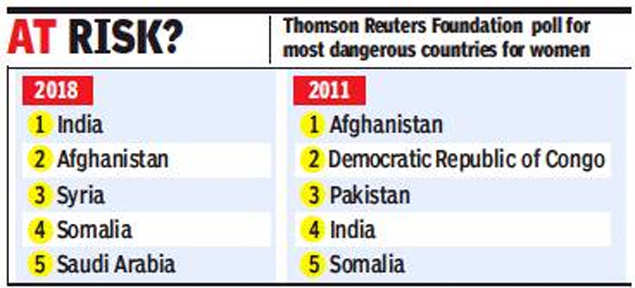New Delhi: India is the world’s most dangerous country for women due to the high risk of sexual violence and being forced into slave labor, according to a poll of global experts released on June 26. Experts said India moving to the top of poll showed not enough was being done to tackle the danger women faced, more than five years after the rape and murder of a student on a bus in Delhi made violence against women a national priority. “India has shown utter disregard and disrespect for women ... rape, marital rapes, sexual assault and harassment, female infanticide has gone unabated,” said Manjunath Gangadhara, an official at the Karnataka state government. “The (world’s) fastest growing economy and leader in space and technology is shamed for violence committed against women.” Government data shows reported cases of crime against women rose by 83% between 2007 and 2016, when there were four cases of rape reported every hour. The poll was a repeat of a survey in 2011 that found experts saw Afghanistan, Democratic Republic of Congo, Pakistan, India, and Somalia as the most dangerous countries for women. The survey asked respondents which five of the 193 United Nations member states they thought were most dangerous for women and which country was worst in terms of healthcare, economic resources, cultural or traditional practices, sexual violence and harassment, non-sexual violence and human trafficking. Respondents also ranked India the most dangerous country for women in terms of human trafficking, including sex slavery and domestic servitude, and for customary practices such as forced marriage, stoning and female infanticide. Indian Ministry of Women and Child Development declined to comment on the survey results. India, Libya and Myanmar were considered the world’s most dangerous nations for women exploited by human traffickers in a global crime worth an estimated $150 billion a year. The poll of 548 people was conducted online, by phone and in person between March 26 and May 4 with an even spread across Europe, Africa, the Americas, South East Asia, South Asia and the Pacific. Respondents included aid professionals, academics, healthcare staff, non-government organization workers, policy-makers, development specialists and social commentators. (The story has been published from a wire feed, with modifications to the text and headline)
India most dangerous country for women due to high risk of sexual violence: Poll
- by Rinku
- June 26, 2018 2 minutes

India











